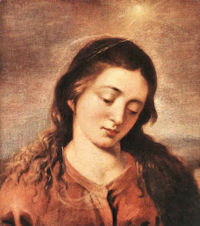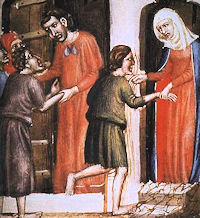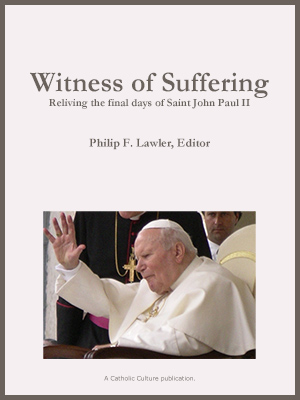Make your gift today!
Help keep Catholics around the world educated and informed.
Already donated? Log in to stop seeing these donation pop-ups.
Ordinary Time: June 10th
Memorial of Mary, Mother of Church; Monday of the Tenth Week of Ordinary Time
Other Commemorations: St. Landericus, Bishop (RM); Bl. Bogumilus, Bishop (RM) ; Other Titles: St. Landry
» Enjoy our Liturgical Seasons series of e-books!
Pope Francis has decreed that the ancient devotion to the Blessed Virgin Mary, under the title of Mother of the Church, be inserted into the Roman Calendar.
The liturgical celebration, B. Mariæ Virginis, Ecclesiæ Matris, will be celebrated annually as a Memorial on the day after Pentecost.
St. Landericus was the Bishop of Paris from 650 to his death. He is best remembered as the founder of the first hospital in Paris.
According to the 1962 Missal of St. John XXIII the Extraordinary Form of the Roman Rite, today is the feast of St. Margaret of Scotland. In the Ordinary Rite her feast is celebrated on November 16.
Mary, Mother of the Church
By issuing the Decree on the celebration of the feast of Mary, Mother of the Church, Pope Francis wishes to promote this devotion in order to “encourage the growth of the maternal sense of the Church in the pastors, religious and faithful, as well as a growth of genuine Marian piety”.
The decree reflects on the history of Marian theology in the Church’s liturgical tradition and the writings of the Church Fathers.
 It says Saint Augustine and Pope Saint Leo the Great both reflected on the Virgin Mary’s importance in the mystery of Christ.
It says Saint Augustine and Pope Saint Leo the Great both reflected on the Virgin Mary’s importance in the mystery of Christ.
“In fact the former [St. Augustine] says that Mary is the mother of the members of Christ, because with charity she cooperated in the rebirth of the faithful into the Church, while the latter [St. Leo the Great] says that the birth of the Head is also the birth of the body, thus indicating that Mary is at once Mother of Christ, the Son of God, and mother of the members of his Mystical Body, which is the Church.”
The decree says these reflections are a result of the “divine motherhood of Mary and from her intimate union in the work of the Redeemer."
Scripture, the decree says, depicts Mary at the foot of the Cross (cf. Jn 19:25). There she became the Mother of the Church when she “accepted her Son’s testament of love and welcomed all people in the person of the beloved disciple as sons and daughters to be reborn unto life eternal.”
In 1964, the decree says, Pope Paul VI “declared the Blessed Virgin Mary as ‘Mother of the Church, that is to say of all Christian people, the faithful as well as the pastors, who call her the most loving Mother’ and established that 'the Mother of God should be further honoured and invoked by the entire Christian people by this tenderest of titles.’”
St. Landericus of Paris or St. Landry
St. Landericus was a sincere and dedicated servant of God who had great love for the poor and the lowly. He became bishop of Paris in 650 A.D., in the Frankish kingdom (formally Gaul) during the reign of Clovis II and served as bishop until 656 A.D. (some records show until his death in 661).
He was a very earnest and devout man, distinguished especially by his great love of the poor and by his charity during the famine of 651 A.D. To relieve them, he sold not only his personal possessions but also some of the vessels and furniture of the church.
He became increasingly aware that the sick and poor of disease were not really cared for. The custom then was to house the sick in little hotels dependent on the inconsistent care from charitable persons. The saint had the idea to gather the sick under one roof in order to improve their treatment and reduce the risks of contagion, at a time when epidemics were fairly frequent. He founded in 651 the city's first real hospital, dedicated to St. Christopher. It was erected near Notre-Dame on the site of the dwelling place of Erchinoaldus, mayor of the palace In time. After the saint died the name was changed to the now-famous Hotel-Dieu (Hostel of God). This is the oldest hospital in the world still in operation.
Before becoming bishop, Landry had acted as referendary at the Merovingian court. It was he who instructed a monk named Marcolfus to write the Formulae, a collection of formulas used for a variety of legal issues.
St. Landry was also responsible for the Benedictines' setup of the Abbey of Saint-Denis. In 653 AD, he signed, along with 24 other bishops, the famous foundation charter granted by King Clovis to the Abbey (Privilege of Clovis III), exempting it from episcopal jurisdiction. Clovis was the husband of Saint Bathilde, who in those years fostered the founding of numerous monasteries.
He is also credited with having built the Parisian church of Saint-Germain l'Auxerrois, which later became the main parish of the royalty of France. He died around 656 and was buried in this church, where there is a chapel dedicated to him. His relics, except two bones given to the parish of Saint Landry in 1408, are kept in a silver shrine. He is honored with an office in the new Paris Breviary. During the French Revolution, as happened with the bodies of several other saints, the revolutionary fury caused the dispersion of most of his relics.
—Adapted from Daily Compass
Highlights and Things To Do:
- Find out more about the Abbey of Saint-Denis.
- Read more about St. Landry:
- Do a virtual tour of Saint-Germain l'Auxerrois.
- There is a statue of St. Landry, behind the altar of the Church of St. Landry in Opelousas, Louisiana. He is depicted as a bishop, distributing food.
- See more about the Merovingians.
- You can view the original document of Privilege of Clovis III that was granted to the Abbey of Saint-Denis. It is housed in the Musee de L'Histoire de France, Paris, France.
Bl. Bogumilus of Gniezno
Bogumilus was born to the Polish nobility, and the twin brother of Boguphalus. He studied in Paris, France and was ordained a priest. He served at Holy Trinity parish in Dobrow, Poland, a church that he built himself. He had a great dedication to the Blessed Virgin Mary, and loved solitude.
His uncle, the Archbishop of Gniezno, made him the chancellor of Gniezno. Bogumilus later succeededed his uncle as Archbishop of Gniezno in 1167. During his time as archbishop he founded a Cistercian abbey at Koronowo. Through the five years of his episcopacy, he was opposed by his own clergy for his insistence on strict adherance to the clerical discipline and simple lifestyle. He resigned his see in 1172 and became a Camaldolese hermit at Uniedow, Poland for the last decade of his life. He died in 1204.
His cult began immediately after his death, especially in eastern Poland, however the formal process of beatification didn't begin until 1625...and stalled until 1908. Finally Pope Pius XI beatified Bogumilus on May 27, 1925.
—Adapted from CatholicSaints.info
Symbols and Representation: a bishop either having a vision of the Blessed Virgin Mary, holding a fish or walking on the surface of a stream or river.
Patronage: archdiocese of Gniezno, Poland (given by Pope Paul VI)
Highlights and Things To Do:
- Find out more at CatholicSaints.info
- Find out more about the Camaldolese hermits, which were founded by St. Romuald, and are a division of the Benedictines.
- His relics are in the Collegiate Church of the Assumption of the Blessed Virgin Mary, Uniejów, Poland.






